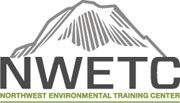|
Description: This hybrid course includes an overview/refresher of key chemistry concepts associated with environmental contamination, provides a foundation for understanding contaminant transport, fate and remediation, and delivers an overview of key concepts essential for understanding soil & groundwater contamination and the selection of appropriate remediation approaches.
The fundamental environmental chemistry overview/refresher takes place on the first day of the course, and is followed by a review of chemical naming rules (e.g., understanding what 1,1,1-TCA is, etc.) and how to use chemical structure to predict molecular geometry and environmental behavior.
On the second day, the material covered expands into the overview of key concepts essential for understanding soil and groundwater contamination and the selection of appropriate remediation approaches. In the second half of Day 2, participants will use spreadsheet models to predict behavior of chemical using simplified examples. Major uncertainties and limitations of modeling approaches will also be discussed. This subject matter is useful for non-modelers who would like to better understand modeling results and the uncertainties associated with them, as well as for individuals who are well versed in modeling but could use a further background in chemistry to improve their skills in interpreting modeling results.
The course material will greatly enhance on-the-job training and is also recommended for project managers seeking a more thorough understanding of contaminant behavior. "I liked that the course started out with a basic overview of Chem, then built on more complex concepts. The course had very good, general information about contamination and was very useful." H. Zrucky, April 2013 "Good progression from chemistry overview into the various environmental chemistry concepts. Instructor was knowledgeable and enthusiastic." P. Sartz, April 2013 "The way we were "eased" back into the organic chemistry was very helpful. I had some pre-course anxiety about that." R. Duncan, April 2013 "[Pam Schultz is an] Excellent speaker, very intense knowledge and a passion for the subject material. Great job!" J. Collins April 2013
|
California Department of Public Health, CDPH, Approved for contact hours
*Reduced tuition is available for Native American tribes, government employees, nonprofits, students and NAEP, NEBC, NWAEP members. You may register online or by calling the Northwest Environmental Training Center at (425) 270-3274.
Please wait to receive a course confirmation email, roughly one month prior to the class, before making any travel arrangements. Education Level: Fundamental refresher to Intermediate
Intended Audience: This course is designed for environmental professionals who require a fundamental understanding of chemistry principles for their work, and is recommended for anyone working with contaminated soil and groundwater who seeks a thorough review of essential topics.
Continuing Education Units: 1.30 CEUs
Course Topics
Day I: The goal for the first day of the course is to provide a refresher of chemistry concepts that are needed to assess contaminant fate and transport. Participants will understand the structure of major contaminants and an gain an understanding of the chemical properties that can be used to predict chemical behavior. The course will also cover sources of chemical property data and approaches to assessing data quality.
Specific topics covered:
• Elements, Compounds and Chemical Mixtures
• Isotopes, Ions, and Chemical Bonds
• Predicting Molecular Geometry and Behavior
• Empirical, Chemical, and Structural Formulas
• Organic Molecules and IUPAC Nomenclature
• Overview of Physical and Chemical Properties: Molecular Weight, Melting point, Boiling point, Solubility, Vapor pressure
• Mass-Based and Molar-Based Concentrations
• Chemical reactions: precipitation, oxidation-reduction , acid-base
• Stoichiometry (balancing reactions)
• Chemical Equilibrium and Limiting Reactants
• Major contaminant groups (e.g., BTEX, PAHs, PCBs, dioxins, halogenated compounds, pesticides)
• Contaminant partitioning and mass transfer
• Non-aqueous phase liquids (NAPLs)
• Contaminant mixtures (e.g., gasoline, coal tars)
• Properties of fluids: Density, Viscosity, and Interfacial tension
Day 2: The goal of the second day is to build upon the material from Day 1 to be able to understand the movement of contaminants in environmental systems. A key goal of Day 2 is to give participants more familiarity with modeling concepts and to be able to use simple models to make predictions of contaminant behavior.
• Hydrogeology Review
• Groundwater Transport
• Retardation and Solute Velocity Calculations
• Contaminant Transport - Advection, Mechanical Dispersion, Diffusion (Chemical Dispersion)
- Adsorption and Absorption (Kd, Koc, foc)
- Advection-Dispersion-Reaction Equations
- Impact of heterogeneity
• NAPLs - Residual Saturation Calculation
• Vapor Transport
• Overview of Natural Attenuation Processes
• Biodegradation Pathways for Common Contaminants
• Case studies of contamination (e.g., gasoline, manufactured gas plants, dry cleaning solvents, metals)
• Overview of risk-based screening levels
About the Instructor
 Dr. Pamela Schultz is an environmental chemist and engineer with over 20 years of experience working in government, industry, and consulting. She obtained her undergraduate degree in chemistry from Providence College in 1992 and her master’s degree in Environmental Systems Engineering from Clemson University in 1996. She worked as a senior environmental engineer at Merck & Co., Inc., conducting contaminant fate and transport modeling and human health risk assessments for air permitting and remediation projects. She later joined RTI International as a research environmental engineer, conducting multimedia fate and transport modeling to support U.S. EPA decision-making. In 2011, she received her PhD in Environmental Sciences and Engineering at the University of North Carolina, studying the behavior of dense non-aqueous liquids in soil and groundwater.
What to Bring
Please bring a calculator, pen or pencil, and notepad if you would like to take notes (you may also choose to take notes in your book). Lunch will be on your own, but drinks and snacks will be provided throughout the day.
Billing Information
In order to guarantee a space in a course, the tuition must be paid in full TWO WEEKS before the first day of the course by either check or credit card. State and government agencies paying with a purchase order are allowed payment under the two-week time frame if a copy of the purchase order is received by NWETC.
If You Need to Cancel
Cancellations*-
With 31 or more days notice, we will offer a 100% refund or credit towards a future course. The credit is good for one year and may be applied to any course.
- With 30-8 days notice, we will offer a course credit towards a future course. The credit is good for one year and may be applied to any course.
- With fewer than 8 days notice, there is no course credit available
*Please note that attendee replacement is welcome at any time
Disability Accommodations
Disability Accommodations:To request disability accommodations, please contact us at info@nwetc.org or 425-270-3274 at least 30 days prior to the event.
|










